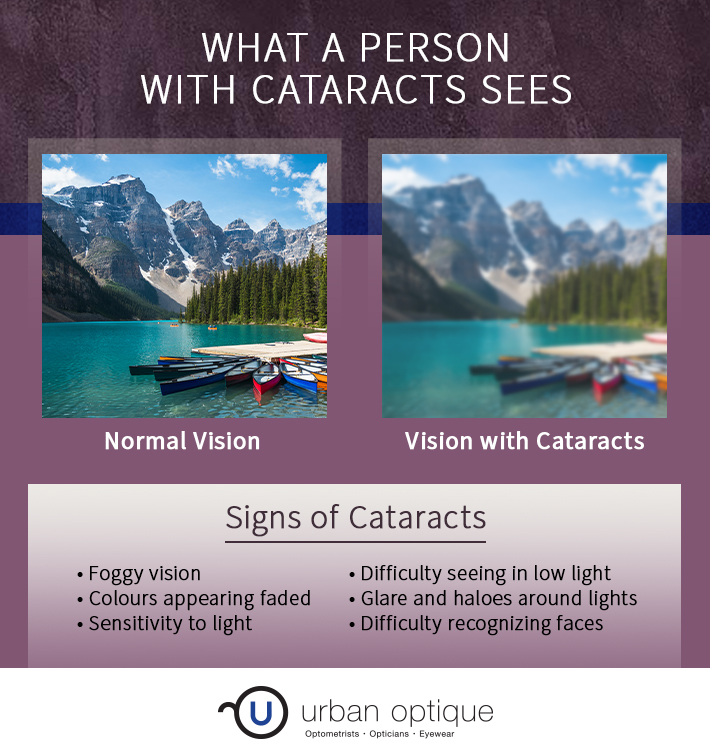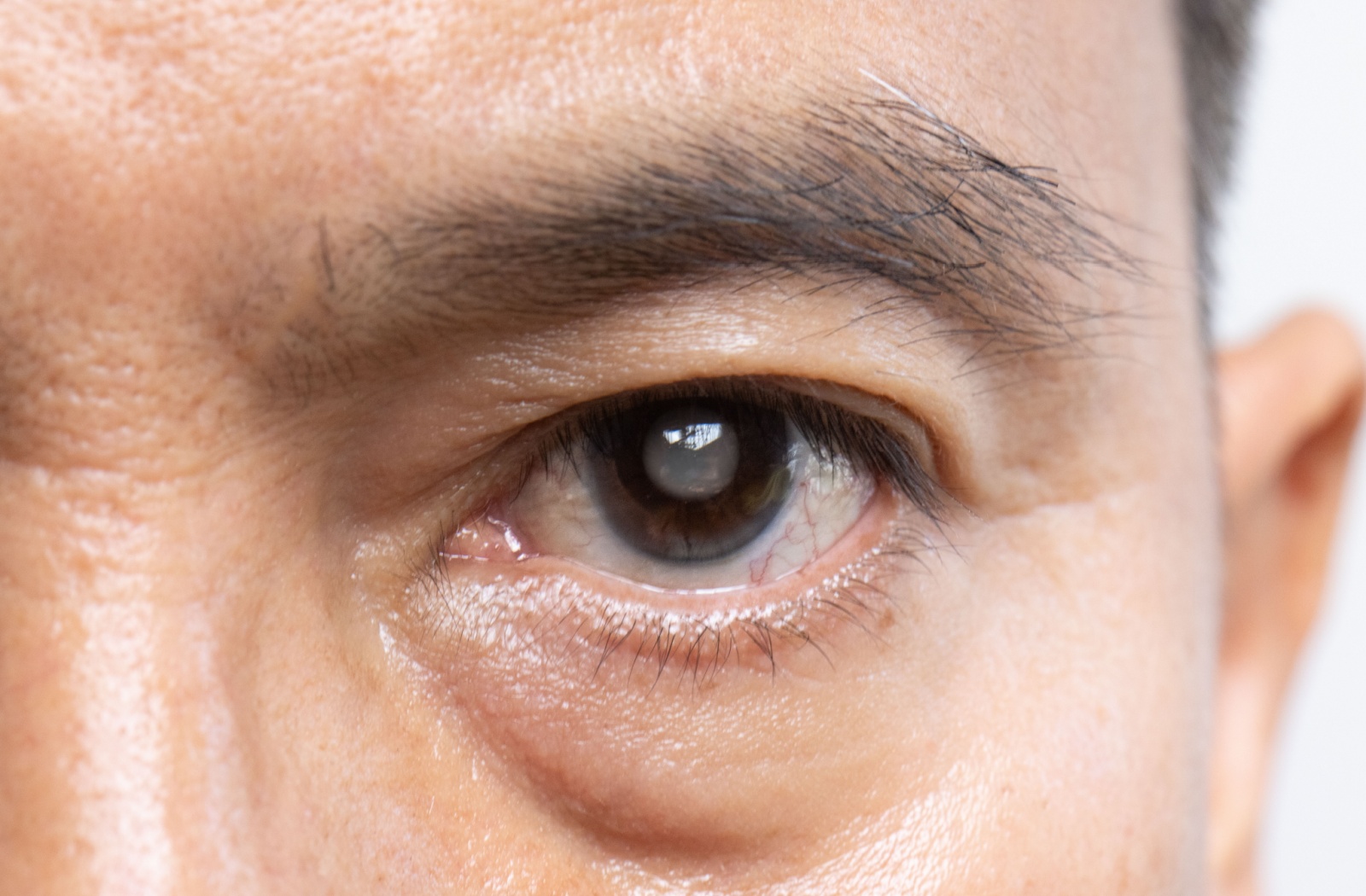Imagine looking at the world through a frosted window—details are blurred, colours are dulled, and clarity is compromised. This is what vision can look like when affected by cataracts.
Cataracts are a common eye condition many people will encounter at some point in their lives, particularly as they age. They occur when the eye’s clear lens becomes cloudy, leading to blurred vision. This condition is prevalent in older adults but can affect individuals of any age.
Over time, cataracts can lead to significant sight impairment, affecting how you see colours and details. Understanding the first signs of cataracts can help you maintain good eye health and address any issues before they worsen.
What Causes Cataracts?
Cataracts form when proteins in the eye’s lens clump together, creating cloudy areas that affect vision. These proteins, normally organized to keep the lens clear and transparent, can begin to deteriorate with age or due to other factors. This deterioration leads to the characteristic clouding of the eye’s lens, obstructing light from passing through clearly. Over time, cataracts can grow larger, making it even more challenging to see clearly.
Several factors contribute to the development of cataracts. Age is the most significant, as cataracts are common in people over 60. However, other factors can accelerate their formation, such as:
- Prolonged exposure to UV rays
- Smoking
- Diabetes
- Certain medications
While cataracts may initially develop slowly, they can eventually lead to significant vision impairment if left untreated. The process of cataract formation is gradual, often taking years before noticeable symptoms appear. Regular eye exams can detect cataracts in their early stages and monitor their development over time.

Cataract Symptoms & Warning Signs
Recognizing the symptoms of cataracts early on can make a significant difference in managing the condition. One of the most common warning signs is blurry or cloudy vision. Other symptoms can include:
- Foggy vision
- Colours appearing faded
- Increased sensitivity to light
- Difficulty seeing in low light
The opacity caused by cataracts can scatter incoming light, leading to glare and haloes around lights. This makes night driving challenging and potentially dangerous. If you experience any of these symptoms, it’s important to consult an eye care professional for a comprehensive examination.
Living with Cataracts
Cataracts can affect your quality of life in various ways. Due to blurry vision, many people find it difficult to perform everyday activities, such as reading, cooking, or using a computer. This can lead to frustration and a decreased sense of independence. Some individuals may struggle with recognizing faces or have difficulty seeing clearly in dim lighting, making social interactions more challenging.
While cataracts can present challenges, there are strategies to manage daily life effectively:
- Optimizing your home and workspace: Using brighter lights and avoiding glare can make it easier to see and reduce eye strain.
- Wearing sunglasses: This can protect your eyes from harmful UV rays and reduce sensitivity to light when you’re outdoors.
- Adopting a healthy lifestyle: A diet rich in antioxidants, vitamins, and minerals can support eye health and potentially slow the progression of cataracts. Quitting smoking and managing chronic conditions like diabetes can further protect your eyes.
- Getting regular eye checkups: Eye exams are essential for monitoring cataracts and adjusting treatment plans as needed. Staying informed about your condition and collaborating with your eye care provider can empower you to make informed decisions about your vision health.
How Cataracts Are Diagnosed & Treated
Diagnosing cataracts involves a thorough eye examination by your eye doctor. This typically includes a visual acuity test, a slit-lamp examination to view the structures of the eye, and a retinal exam. These tests help determine the extent of lens clouding and the impact on vision, allowing for an accurate diagnosis.
Once diagnosed, there are several treatment options available for cataracts. Initially, stronger prescription glasses, anti-glare sunglasses, or magnifying lenses may help manage symptoms. However, as cataracts progress, surgery becomes the most effective option.
Cataract Surgery
Cataract surgery involves removing the cloudy lens and replacing it with an artificial one, known as an intraocular lens (IOL).
Modern cataract surgery is a safe and highly successful procedure. It is typically performed on an outpatient basis and requires only local anesthesia. With technological advancements, patients can often return to regular activities within a few days.
Will Cataracts Come Back After Surgery?
Cataract surgery has a high success rate, with most patients experiencing improved vision and enhanced quality of life. After surgery, patients often report clearer vision, brighter colours, and reduced glare. This transformation can make everyday activities more enjoyable and enable individuals to regain independence.
While cataract surgery is an effective treatment that generally provides permanent results, cataracts can potentially develop again in the form of secondary cataracts or posterior capsule opacification (PCO). This condition occurs when the thin membrane that holds the artificial lens in place becomes cloudy over time, leading to vision issues similar to those experienced before surgery. Fortunately, if PCO occurs, it can be treated easily with a quick outpatient procedure known as YAG laser capsulotomy.
Reclaim Your Vision with Cataract Treatment
Cataracts can significantly impact vision, but you don’t have to live with foggy vision forever. By staying informed and working closely with your eye care provider, you can enjoy a future free from the challenges of cataracts.
If you or a loved one are experiencing symptoms of cataracts, book an appointment at Urban Optique to explore your options for treatment. Whether through regular checkups, professional guidance, or cataract surgery, we’re here to support your vision health every step of the way.
















